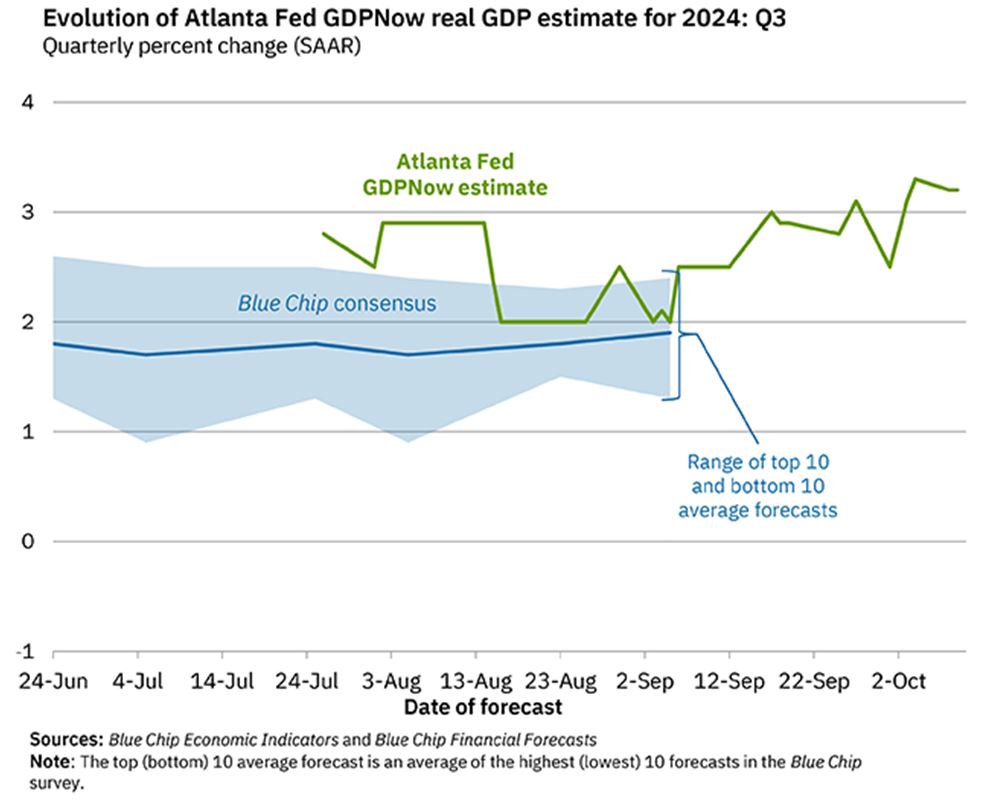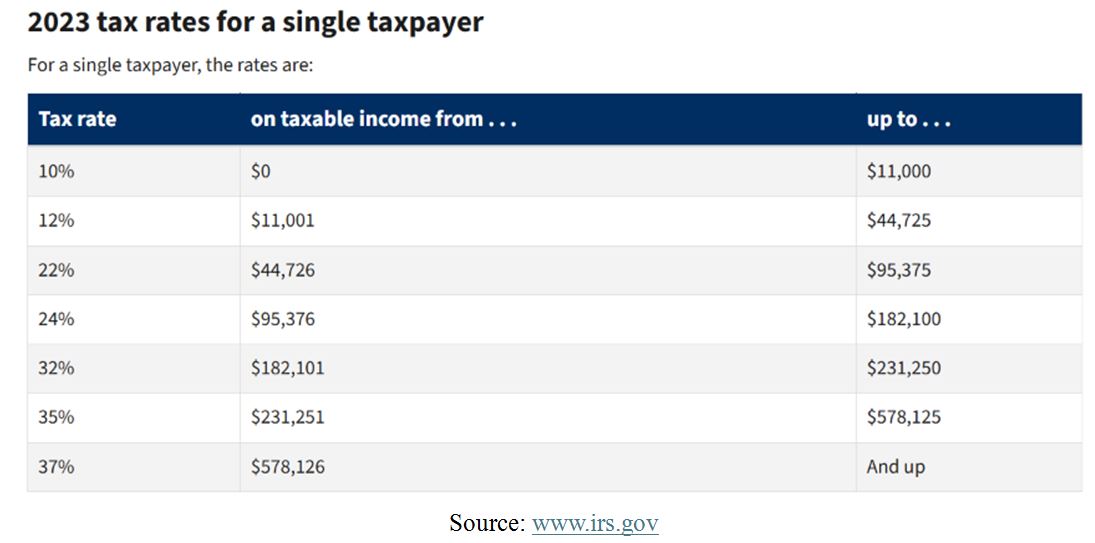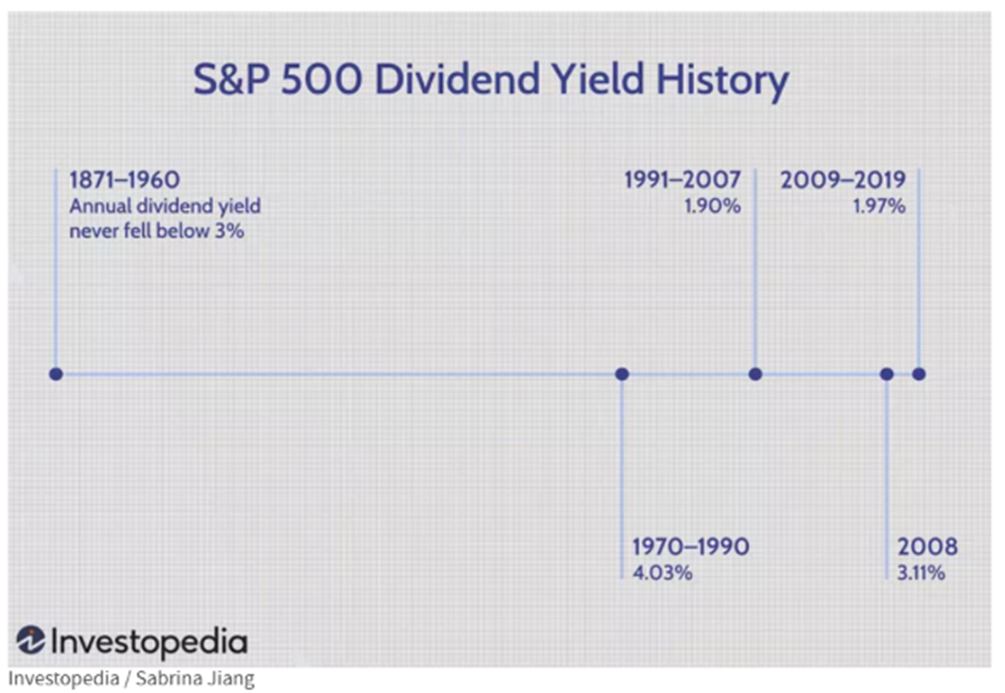by Bryan Perry
October 15, 2024
Third-quarter earnings season is getting off to a good start, with solid numbers coming from the big money center banks. There is rising optimism that the torch-bearing tech sector will deliver strong Q3 sales and earnings as capital investment into AI continues to be robust, according to Wall Street analysts.
The Atlanta Fed has bumped its growth rate for the third quarter back to 3.2%, from its prior revision to 2.5%, implying that they see the recent half-point rate cut by the Fed as positive for corporate earnings.

Graphs are for illustrative and discussion purposes only. Please read important disclosures at the end of this commentary.
The back half of October is historically bullish, partly due to earnings season. This time around, there is over $6 trillion in cash on the sidelines and gas prices are back under $3.00 per gallon in many parts of the country, so that’s a good set up for a higher stock market going into the final weeks before the election.
The most recent (September) employment and inflation data may have set back expectations for further aggressive rate cuts for the balance of 2024. As of October 11, the CME FedWatch Tool forecasts a 90% probability of a quarter-point rate cut at the November 7 FOMC meeting and an 84% chance of another quarter-point cut at the December 18 meeting, which would have the Fed funds rate ending the year at 4.25%-4.50%, but this glide path is absolutely bullish for bonds as well as dividend growth stocks.
There are many stocks that now sport dividend yields that rival Treasury or investment grade corporate bond yields. The big advantage of dividend income versus corresponding fixed income yields is the tax treatment of income. Fixed income is taxed at ordinary income tax rates, per the investor’s tax bracket. The maximum rate applied to qualified dividends is 20%. The highest federal tax rate for income is 37%.
Translated, a bond paying 4% to a high-income earner, nets 2.52%, whereas a qualified dividend paying 4% pays out a net yield of 3.2% This is a material difference when you consider inflation and the fact that “It’s not what you make, but what you keep.” At present, annual inflation is running at 2.4%, so earning 4% in the fixed income market, adjusted for inflation, is often a zero-sum game for high-income earners.

Graphs are for illustrative and discussion purposes only. Please read important disclosures at the end of this commentary.
The main challenge for investors seeking high dividend yields is that dividend growth hasn’t kept up with the market. Dividend yields from blue-chip U.S. companies have been trending downwards over time, as evidenced by the Standard & Poor’s 500 Index dividend yield of approximately 1.78% at year-end 2022, trending lower throughout 2023 and currently only 1.21% for the SPDR S&P 500 Index ETF (SPY).
This 1.21% yield is well under the index’s long-run average yield of 2.91%. In fact, dividend yields have remained relatively low (below 3%) since 1992. This slowing of dividend growth over time is one more sign that smaller (lower) dividends remain “the new normal.” A quick review of the history of the S&P 500 reveals just how abnormal these sub-3% annual yields have been – for the last 150 years. Because of highly proactive monetary policy and the rise of technology stocks, today’s dividend investors have a bigger challenge to find great yields among great stocks. But, they are out there, just not in big numbers.

Graphs are for illustrative and discussion purposes only. Please read important disclosures at the end of this commentary.
The sharp change in S&P 500 dividend yield traces back to the 1990s. For example, the average dividend yield between 1970 and 1990 was 4.21%, according to NYU Stern’s Aswath Damodaran. It declined to 1.95% between 1991 and 2007. After a brief climb to about 3.15% during the peak of the 2008 Great Recession, the annual S&P 500 dividend yield averaged just 1.98% between 2009 and 2019. From 2020 on, the dividend yield fell below 2% and has stayed between 1.24% to 1.78% since then.
Looking at the S&P 500’s 11 sectors, the highest yielding sectors are the Utilities Select Sector SPDR ETF (XLU), paying 2.79%, and the Consumer Staples Select Sector SPDR ETF (XLP), paying 2.58%, so it seems clear that conventional ETF sector investing can’t satisfy the need for qualified dividend yields. This is where investors will have to exercise due diligence to find some blue-chip (and maybe some not-so-blue-chip) stocks that pay dividend yields in excess of 4% to stay ahead of long-term inflation and the tax man. This is the new world we live in, and it is only going to get more difficult.
There are just a handful of stocks in which a well-rounded portfolio of dividend stocks can be crafted as this new lower rate cycle takes hold. Here are a few examples of blue-chip stocks that fit the profile of paying outsized yields and have bullish chart patterns (moving up and to the right).

Bryan Perry has no position in these stocks
It’s an ideal time to lock in qualified dividend yields – and look for potential capital gains as well.
Navellier & Associates owns Verizon Communications Inc. (VZ), and Bristol Meyers Squibb Co. (BMY), in some managed accounts. We do not own AT&T (T) Dominion Energy Inc. (D), Kinder Morgan Inc. (KMI), Prudential Financial, Inc. (PRU), in managed accounts. Bryan Perry does not personally own Verizon Communications Inc. (VZ), AT&T (T) Dominion Energy Inc. (D), Kinder Morgan Inc. (KMI), Bristol Meyers Squibb Co. (BMY), Prudential Financial Inc. (PRU).
All content above represents the opinion of Bryan Perry of Navellier & Associates, Inc.
Also In This Issue
A Look Ahead by Louis Navellier
The Futuristic World of “Robotaxi” is Finally Here
Income Mail by Bryan Perry
The Challenge of Finding High-Quality Yields in a Rising Market
Growth Mail by Gary Alexander
Who Should Win This Week’s Nobel Prize for Economics?
Global Mail by Ivan Martchev
We’re Seeing Some Seasonality in Reverse
Sector Spotlight by Jason Bodner
Why the Media Don’t Want You to Know the Truth about Their Reporting
View Full Archive
Read Past Issues Here

Bryan Perry
SENIOR DIRECTOR
Bryan Perry is a Senior Director with Navellier Private Client Group, advising and facilitating high net worth investors in the pursuit of their financial goals.
Bryan’s financial services career spanning the past three decades includes over 20-years of wealth management experience with Wall Street firms that include Bear Stearns, Lehman Brothers and Paine Webber, working with both retail and institutional clients. Bryan earned a B.A. in Political Science from Virginia Polytechnic Institute & State University and currently holds a Series 65 license. All content of “Income Mail” represents the opinion of Bryan Perry
Important Disclosures:
Although information in these reports has been obtained from and is based upon sources that Navellier believes to be reliable, Navellier does not guarantee its accuracy and it may be incomplete or condensed. All opinions and estimates constitute Navellier’s judgment as of the date the report was created and are subject to change without notice. These reports are for informational purposes only and are not a solicitation for the purchase or sale of a security. Any decision to purchase securities mentioned in these reports must take into account existing public information on such securities or any registered prospectus.To the extent permitted by law, neither Navellier & Associates, Inc., nor any of its affiliates, agents, or service providers assumes any liability or responsibility nor owes any duty of care for any consequences of any person acting or refraining to act in reliance on the information contained in this communication or for any decision based on it.
Past performance is no indication of future results. Investment in securities involves significant risk and has the potential for partial or complete loss of funds invested. It should not be assumed that any securities recommendations made by Navellier. in the future will be profitable or equal the performance of securities made in this report. Dividend payments are not guaranteed. The amount of a dividend payment, if any, can vary over time and issuers may reduce dividends paid on securities in the event of a recession or adverse event affecting a specific industry or issuer.
None of the stock information, data, and company information presented herein constitutes a recommendation by Navellier or a solicitation to buy or sell any securities. Any specific securities identified and described do not represent all of the securities purchased, sold, or recommended for advisory clients. The holdings identified do not represent all of the securities purchased, sold, or recommended for advisory clients and the reader should not assume that investments in the securities identified and discussed were or will be profitable.
Information presented is general information that does not take into account your individual circumstances, financial situation, or needs, nor does it present a personalized recommendation to you. Individual stocks presented may not be suitable for every investor. Investment in securities involves significant risk and has the potential for partial or complete loss of funds invested. Investment in fixed income securities has the potential for the investment return and principal value of an investment to fluctuate so that an investor’s holdings, when redeemed, may be worth less than their original cost.
One cannot invest directly in an index. Index is unmanaged and index performance does not reflect deduction of fees, expenses, or taxes. Presentation of Index data does not reflect a belief by Navellier that any stock index constitutes an investment alternative to any Navellier equity strategy or is necessarily comparable to such strategies. Among the most important differences between the Indices and Navellier strategies are that the Navellier equity strategies may (1) incur material management fees, (2) concentrate its investments in relatively few stocks, industries, or sectors, (3) have significantly greater trading activity and related costs, and (4) be significantly more or less volatile than the Indices.
ETF Risk: We may invest in exchange traded funds (“ETFs”) and some of our investment strategies are generally fully invested in ETFs. Like traditional mutual funds, ETFs charge asset-based fees, but they generally do not charge initial sales charges or redemption fees and investors typically pay only customary brokerage fees to buy and sell ETF shares. The fees and costs charged by ETFs held in client accounts will not be deducted from the compensation the client pays Navellier. ETF prices can fluctuate up or down, and a client account could lose money investing in an ETF if the prices of the securities owned by the ETF go down. ETFs are subject to additional risks:
- ETF shares may trade above or below their net asset value;
- An active trading market for an ETF’s shares may not develop or be maintained;
- The value of an ETF may be more volatile than the underlying portfolio of securities the ETF is designed to track;
- The cost of owning shares of the ETF may exceed those a client would incur by directly investing in the underlying securities; and
- Trading of an ETF’s shares may be halted if the listing exchange’s officials deem it appropriate, the shares are delisted from the exchange, or the activation of market-wide “circuit breakers” (which are tied to large decreases in stock prices) halts stock trading generally.
Grader Disclosures: Investment in equity strategies involves substantial risk and has the potential for partial or complete loss of funds invested. The sample portfolio and any accompanying charts are for informational purposes only and are not to be construed as a solicitation to buy or sell any financial instrument and should not be relied upon as the sole factor in an investment making decision. As a matter of normal and important disclosures to you, as a potential investor, please consider the following: The performance presented is not based on any actual securities trading, portfolio, or accounts, and the reported performance of the A, B, C, D, and F portfolios (collectively the “model portfolios”) should be considered mere “paper” or pro forma performance results based on Navellier’s research.
Investors evaluating any of Navellier & Associates, Inc.’s, (or its affiliates’) Investment Products must not use any information presented here, including the performance figures of the model portfolios, in their evaluation of any Navellier Investment Products. Navellier Investment Products include the firm’s mutual funds and managed accounts. The model portfolios, charts, and other information presented do not represent actual funded trades and are not actual funded portfolios. There are material differences between Navellier Investment Products’ portfolios and the model portfolios, research, and performance figures presented here. The model portfolios and the research results (1) may contain stocks or ETFs that are illiquid and difficult to trade; (2) may contain stock or ETF holdings materially different from actual funded Navellier Investment Product portfolios; (3) include the reinvestment of all dividends and other earnings, estimated trading costs, commissions, or management fees; and, (4) may not reflect prices obtained in an actual funded Navellier Investment Product portfolio. For these and other reasons, the reported performances of model portfolios do not reflect the performance results of Navellier’s actually funded and traded Investment Products. In most cases, Navellier’s Investment Products have materially lower performance results than the performances of the model portfolios presented.
This report contains statements that are, or may be considered to be, forward-looking statements. All statements that are not historical facts, including statements about our beliefs or expectations, are “forward-looking statements” within the meaning of The U.S. Private Securities Litigation Reform Act of 1995. These statements may be identified by such forward-looking terminology as “expect,” “estimate,” “plan,” “intend,” “believe,” “anticipate,” “may,” “will,” “should,” “could,” “continue,” “project,” or similar statements or variations of such terms. Our forward-looking statements are based on a series of expectations, assumptions, and projections, are not guarantees of future results or performance, and involve substantial risks and uncertainty as described in Form ADV Part 2A of our filing with the Securities and Exchange Commission (SEC), which is available at www.adviserinfo.sec.gov or by requesting a copy by emailing info@navellier.com. All of our forward-looking statements are as of the date of this report only. We can give no assurance that such expectations or forward-looking statements will prove to be correct. Actual results may differ materially. You are urged to carefully consider all such factors.
FEDERAL TAX ADVICE DISCLAIMER: As required by U.S. Treasury Regulations, you are informed that, to the extent this presentation includes any federal tax advice, the presentation is not written by Navellier to be used, and cannot be used, for the purpose of avoiding federal tax penalties. Navellier does not advise on any income tax requirements or issues. Use of any information presented by Navellier is for general information only and does not represent tax advice either express or implied. You are encouraged to seek professional tax advice for income tax questions and assistance.
IMPORTANT NEWSLETTER DISCLOSURE:The hypothetical performance results for investment newsletters that are authored or edited by Louis Navellier, including Louis Navellier’s Growth Investor, Louis Navellier’s Breakthrough Stocks, Louis Navellier’s Accelerated Profits, and Louis Navellier’s Platinum Club, are not based on any actual securities trading, portfolio, or accounts, and the newsletters’ reported hypothetical performances should be considered mere “paper” or proforma hypothetical performance results and are not actual performance of real world trades. Navellier & Associates, Inc. does not have any relation to or affiliation with the owner of these newsletters. There are material differences between Navellier Investment Products’ portfolios and the InvestorPlace Media, LLC newsletter portfolios authored by Louis Navellier. The InvestorPlace Media, LLC newsletters contain hypothetical performance that do not include transaction costs, advisory fees, or other fees a client might incur if actual investments and trades were being made by an investor. As a result, newsletter performance should not be used to evaluate Navellier Investment services which are separate and different from the newsletters. The owner of the newsletters is InvestorPlace Media, LLC and any questions concerning the newsletters, including any newsletter advertising or hypothetical Newsletter performance claims, (which are calculated solely by Investor Place Media and not Navellier) should be referred to InvestorPlace Media, LLC at (800) 718-8289.
Please note that Navellier & Associates and the Navellier Private Client Group are managed completely independent of the newsletters owned and published by InvestorPlace Media, LLC and written and edited by Louis Navellier, and investment performance of the newsletters should in no way be considered indicative of potential future investment performance for any Navellier & Associates separately managed account portfolio. Potential investors should consult with their financial advisor before investing in any Navellier Investment Product.
Navellier claims compliance with Global Investment Performance Standards (GIPS). To receive a complete list and descriptions of Navellier’s composites and/or a presentation that adheres to the GIPS standards, please contact Navellier or click here. It should not be assumed that any securities recommendations made by Navellier & Associates, Inc. in the future will be profitable or equal the performance of securities made in this report.
FactSet Disclosure: Navellier does not independently calculate the statistical information included in the attached report. The calculation and the information are provided by FactSet, a company not related to Navellier. Although information contained in the report has been obtained from FactSet and is based on sources Navellier believes to be reliable, Navellier does not guarantee its accuracy, and it may be incomplete or condensed. The report and the related FactSet sourced information are provided on an “as is” basis. The user assumes the entire risk of any use made of this information. Investors should consider the report as only a single factor in making their investment decision. The report is for informational purposes only and is not intended as an offer or solicitation for the purchase or sale of a security. FactSet sourced information is the exclusive property of FactSet. Without prior written permission of FactSet, this information may not be reproduced, disseminated or used to create any financial products. All indices are unmanaged and performance of the indices include reinvestment of dividends and interest income, unless otherwise noted, are not illustrative of any particular investment and an investment cannot be made in any index. Past performance is no guarantee of future results.
